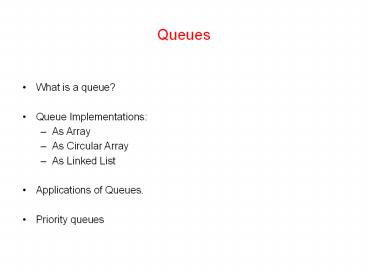Queues - PowerPoint PPT Presentation
Title:
Queues
Description:
Queues What is a queue? Queue Implementations: As Array As Circular Array As Linked List Applications of Queues. Priority queues What is a queue? Queues are linear ... – PowerPoint PPT presentation
Number of Views:163
Avg rating:3.0/5.0
Title: Queues
1
Queues
- What is a queue?
- Queue Implementations
- As Array
- As Circular Array
- As Linked List
- Applications of Queues.
- Priority queues
2
What is a queue?
- Queues are linear data structures in which we add
elements to one end and remove them from the
other end. - The first item to be en-queued is the first to be
de-queued. Queue is therefore called a First In
First Out (FIFO) structure. - Queue operations
- Enqueue
- Dequeue
- GetHead
3
What is a queue?
Rear
Front
3 1 4
Given the following Queue, how will it change
when we apply the given operations?
enqueue(1)
3 1 4 1
enqueue(5)
3 1 4 1 5
dequeue()
1 4 1 5
dequeue()
4 1 5
1 5
dequeue()
4
Queue Implementation
- In our implementation, a queue is a container
that extends the AbstractContainer class and
implements the Queue interface. - We provide three implementations for Queue
- QueueAsArray
- QueueAsCircularArray
- QueueAsLinkedList
public interface Queue extends Container
public abstract Object getHead() public
abstract void enqueue(Object obj) public
abstract Object dequeue()
5
QueueAsArray
- public class QueueAsArray extends
AbstractContainer - implements Queue
- protected Object array
- protected int rear 0
- protected int size
- public QueueAsArray(int size)
- array new Objectsize
- this.size size
- public void purge()
- int index 0
- while(count gt 0)
- arrayindex null
- index
- count--
Complexity is O(n)
6
QueueAsArray (Cont.)
- public Object getHead()
- if(count 0)
- throw new ContainerEmptyException()
- else
- return array0
- public void enqueue(Object obj)
- if(count size)
- throw new ContainerFullException()
- else
- arrayrear obj
- count
Complexity is O(1)
Complexity is O(1)
7
QueueAsArray (Cont.)
- public Object dequeue()
- if(count 0)
- throw new ContainerEmptyException()
- else
- Object obj array0
- count--
- for(int k 1 k lt count k)
- arrayk - 1 arrayk
- rear--
- return obj
Complexity is O(n)
8
QueueAsArray (Cont.)
- public Iterator iterator()
- return new Iterator()
- int index 0
- public boolean hasNext()
- return index lt count
- public Object next()
- if(index count)
- throw new NoSuchElementException()
- else
- Object obj arrayindex
- return obj
9
QueueAsCircularArray Implementation
- By using modulo arithmetic for computing array
indexes, we can have a queue implementation in
which each of the operations enqueue, dequeue,
and getHead has complexity O(1)
Enqueue(P) will result in
10
QueueAsCircularArray Implementation (Cont.)
Dequeue() will result in
11
QueueAsCircularArray
- public class QueueAsCircularArray extends
AbstractContainer - implements Queue
- protected Object array
- protected int front 0
- protected int rear 0
- protected int size
- public QueueAsCircularArray(int size)
- array new Objectsize this.size
size - public void purge()
- int index front
- while(count gt 0)
- arrayindex null
- index (index 1) size
- count--
- front rear 0
Complexity is O(n)
12
QueueAsCircularArray
- public Object getHead()
- if(count 0) throw new
ContainerEmptyException() - else return arrayfront
- public void enqueue(Object obj)
- if(count size) throw new
ContainerFullException() - else
- arrayrear obj
- rear (rear 1) size
- count
- public Object dequeue()
- if(count 0)throw new
ContainerEmptyException() - else
- Object obj arrayfront
- front (front 1) size
Complexity is O(1)
Complexity is O(1)
Complexity is O(1)
13
QueueAsCircularArray
- public Iterator iterator()
- return new Iterator()
- int index front
- int counter 0
- public boolean hasNext()
- return counter lt count
- public Object next()
- if(counter count)
- throw new NoSuchElementExcepti
on() - else
- Object obj arrayindex
- index (index 1) size
- counter
- return obj
14
QueueAsLinkedList
- public class QueueAsLinkedList extends
AbstractContainer - implements Queue
- protected MyLinkedList list
- public QueueAsLinkedList()list new
MyLinkedList() - public void purge()
- list.purge()
- count 0
- public Object getHead()
- if(count 0)
- throw new ContainerEmptyException()
- else
- return list.getFirst()
Complexity is O(1)
Complexity is O(1)
15
QueueAsLinkedList
- public void enqueue(Object obj)
- list.append(obj)
- count
- public Object dequeue()
- if(count 0)
- throw new ContainerEmptyException()
- else
- Object obj list.getFirst()
- list.extractFirst()
- count--
- return obj
Complexity is O(1)
Complexity is O(1)
16
QueueAsLinkedList
- public Iterator iterator()
- return new Iterator()
- MyLinkedList.Element position
list.getHead() - public boolean hasNext()
- return position ! null
- public Object next()
- if(position null)
- throw new NoSuchElementExcepti
on() - else
- Object obj
position.getData() - position position.getNext()
- return obj
17
Application of Queues
- Direct applications
- Waiting lines Queues are commonly used in
systems where waiting line has to be maintained
for obtaining access to a resource. For example,
an operating system may keep a queue of processes
that are waiting to run on the CPU. - Access to shared resources (e.g., printer)
- Multiprogramming
- Indirect applications
- Auxiliary data structure for algorithms
- Component of other data structures
18
Priority Queues
- In a normal queue the enqueue operation add an
item at the back of the queue, and the dequeue
operation removes an item at the front of the
queue. - A priority queue is a queue in which the dequeue
operation removes an item at the front of the
queue but the enqueue operation insert items
according to their priorities. - A higher priority item is always enqueued before
a lower priority element. - An element that has the same priority as one or
more elements in the queue is enqueued after all
the elements with that priority.































